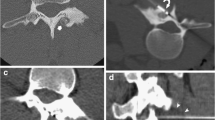Summary
Osteoid osteomas are tumors with intense clinical symptoms and extensive reactive bone changes far exceeding the volume of the lesion itself. Because of their small size they can be approached by minimally invasive surgical procedures. We treated ten symptomatic patients with osteoid osteomas (n 6 hip point, n 1 iliac bone, n 1 femoral diaphysis, n2 tibial diaphysis) by excision of the nidus with a 3-mm Harlow-Wood needle using a percutaneous CT-guided approach. Seven patients with residual tumor were treated with either thermocautery (n 2) or sclerosis with 1 ml of 96% ethanol (n 5). Six patients had instant and constant relief (3 years' observation) of their pain. In two patients a second transcutaneous intervention was successful. Only two patients needed open resection. Compared with the invasive open resection of the tumors, sometimes even putting the stability of the femoral neck at risk, transcutaneous CT-guided enucleation of the nidus of the osteoid osteoma with additional sclerotherapy is a good alternative method, especially in the region of the femoral neck.
Zusammenfassung
Als kleiner Tumor mit zumeist starken klinischen Symptomen und ausgeprägten, das Volumen des eigentlichen Tumors weit übersteigenden reaktiven Veränderungen bietet sich das Osteoidosteom für minimal-invasive chirurgische Maßnahmen an. Bei 10 symptomatischen Patienten (8 – 39 Jahre) mit Osteoidosteomen (6mal Hüftgelenk, einmal linke Beckenschaufel, einmal Femurdiaphyse, 2mal Tibiadiaphyse) haben wir den Nidus unter CT-Kontrolle über einen transkutanen Zugang mit einer 3-mm-Harlow-Wood-Nadel ausgebohrt. Bei 7 Patienten wurde der verbliebene Tumoranteil ergänzend mit Thermokauter (n = 2) oder durch Injektion von 1 ml 96%igem Alkohol (n = 5) verödet. Bei 6 Patienten bildete sich die klinische Symptomatik frühzeitig und dauerhaft zurück (maximale Beobachtungszeit 3 Jahre). Bei 2 Patienten mußte ein 2. transkutaner Eingriff vorgenommen werden; 2 Patienten wurden offen nachreseziert. Im Vergleich zu der oft sehr aufwendigen und gelegentlich auch stabilitätsgefährdenden offenen Tumorresektion, insbesondere am Hüftgelenk, stellt die transkutane CT-gesteuerte Tumorenukleation durch Ausbohrung und ergänzende Sklerosierung eine gute alternative Methode dar.
Similar content being viewed by others
Author information
Authors and Affiliations
Rights and permissions
About this article
Cite this article
Berning, W., Freyschmidt, J. & Wiens, J. Zur perkutanen Therapie des Osteoidosteoms. Unfallchirurg 100, 536–540 (1997). https://doi.org/10.1007/s001130050154
Published:
Issue Date:
DOI: https://doi.org/10.1007/s001130050154




